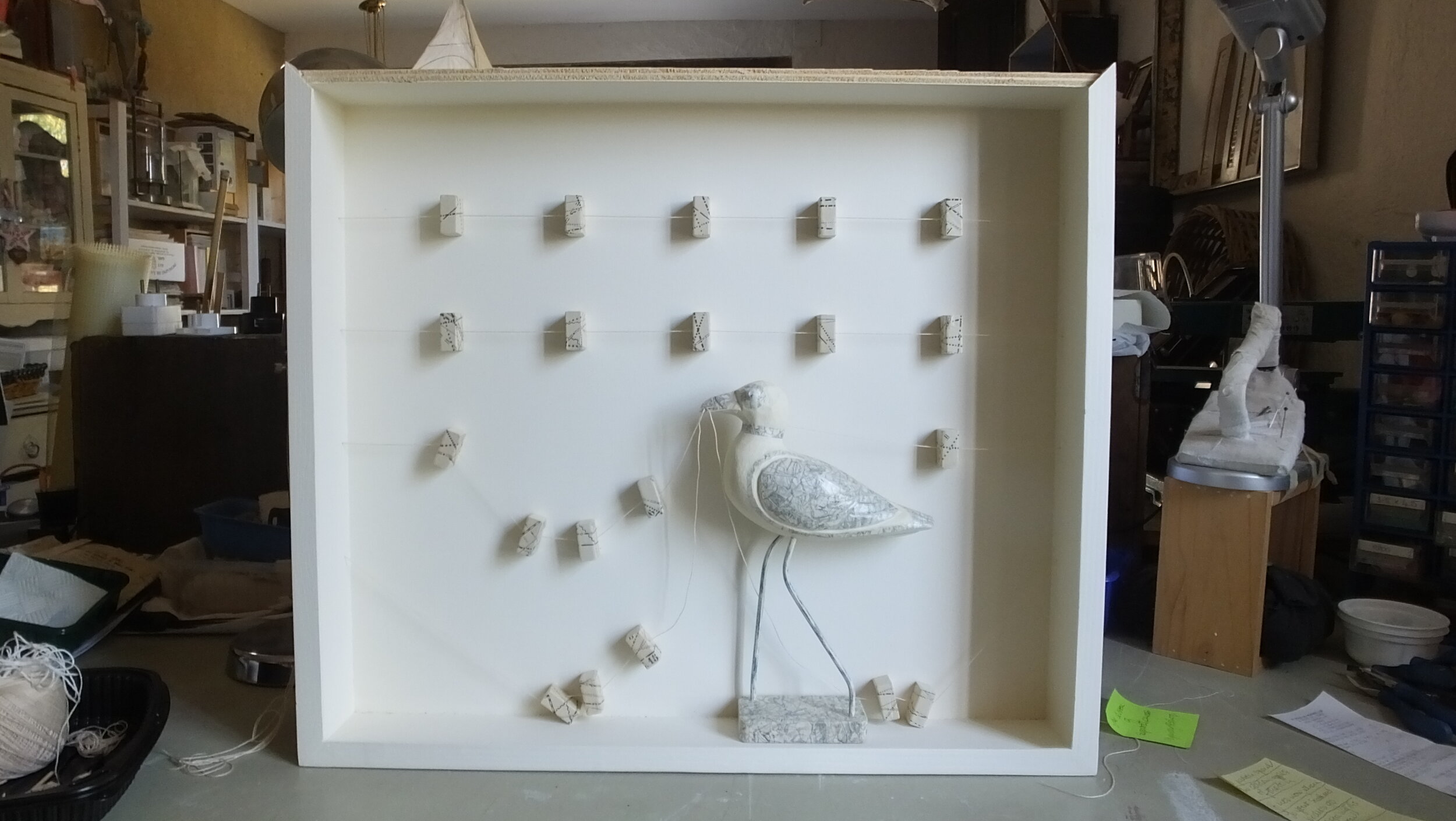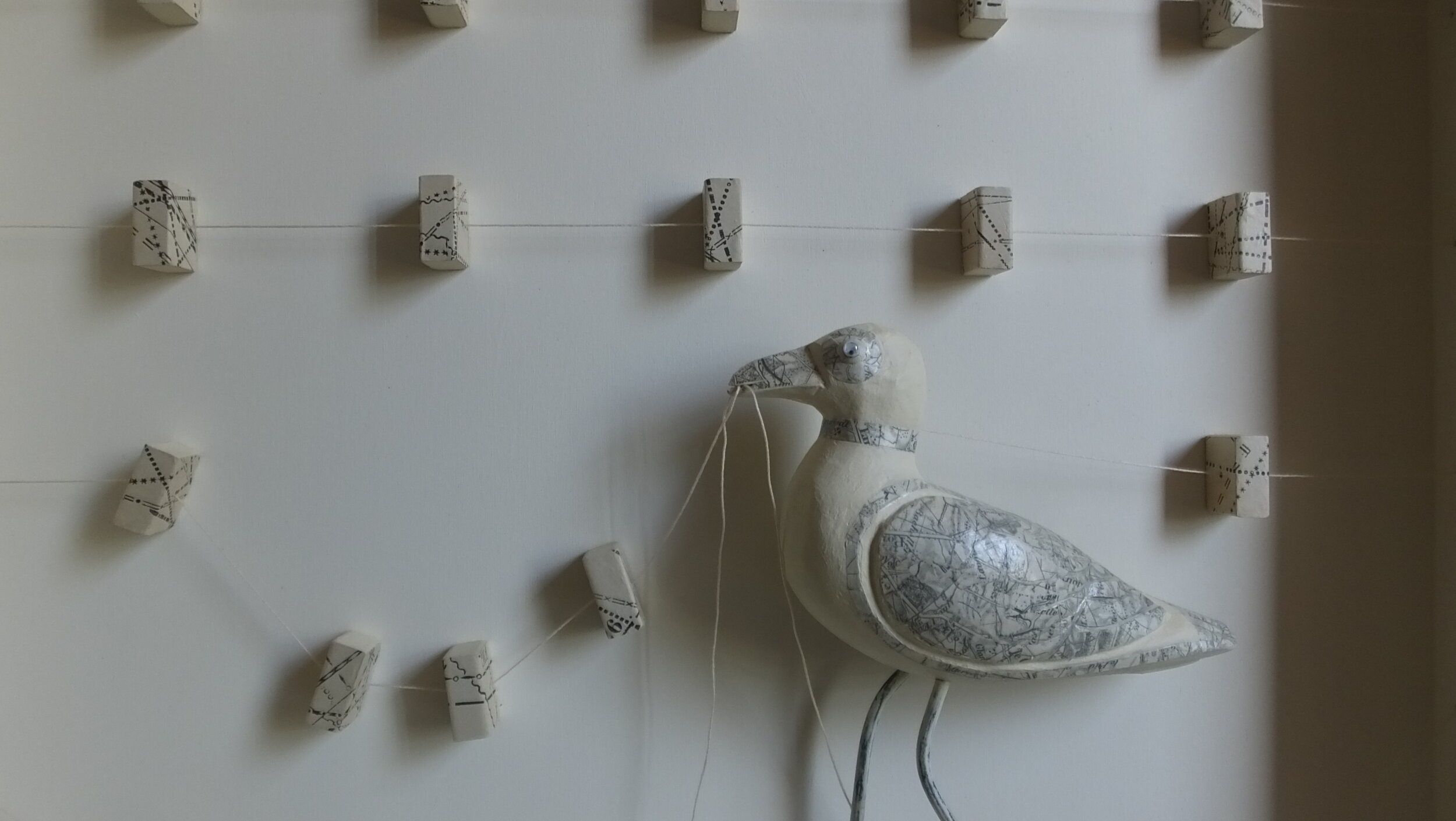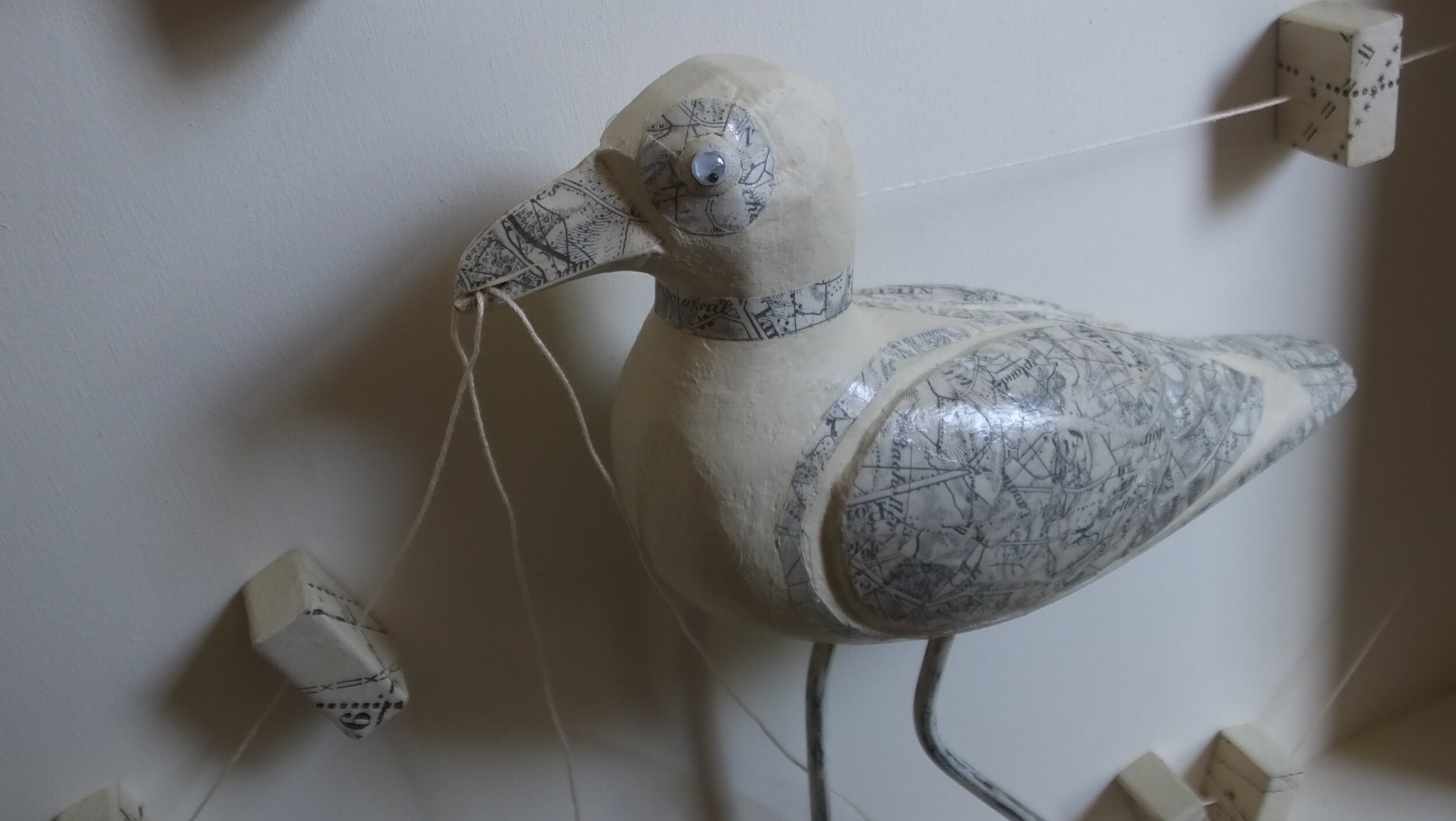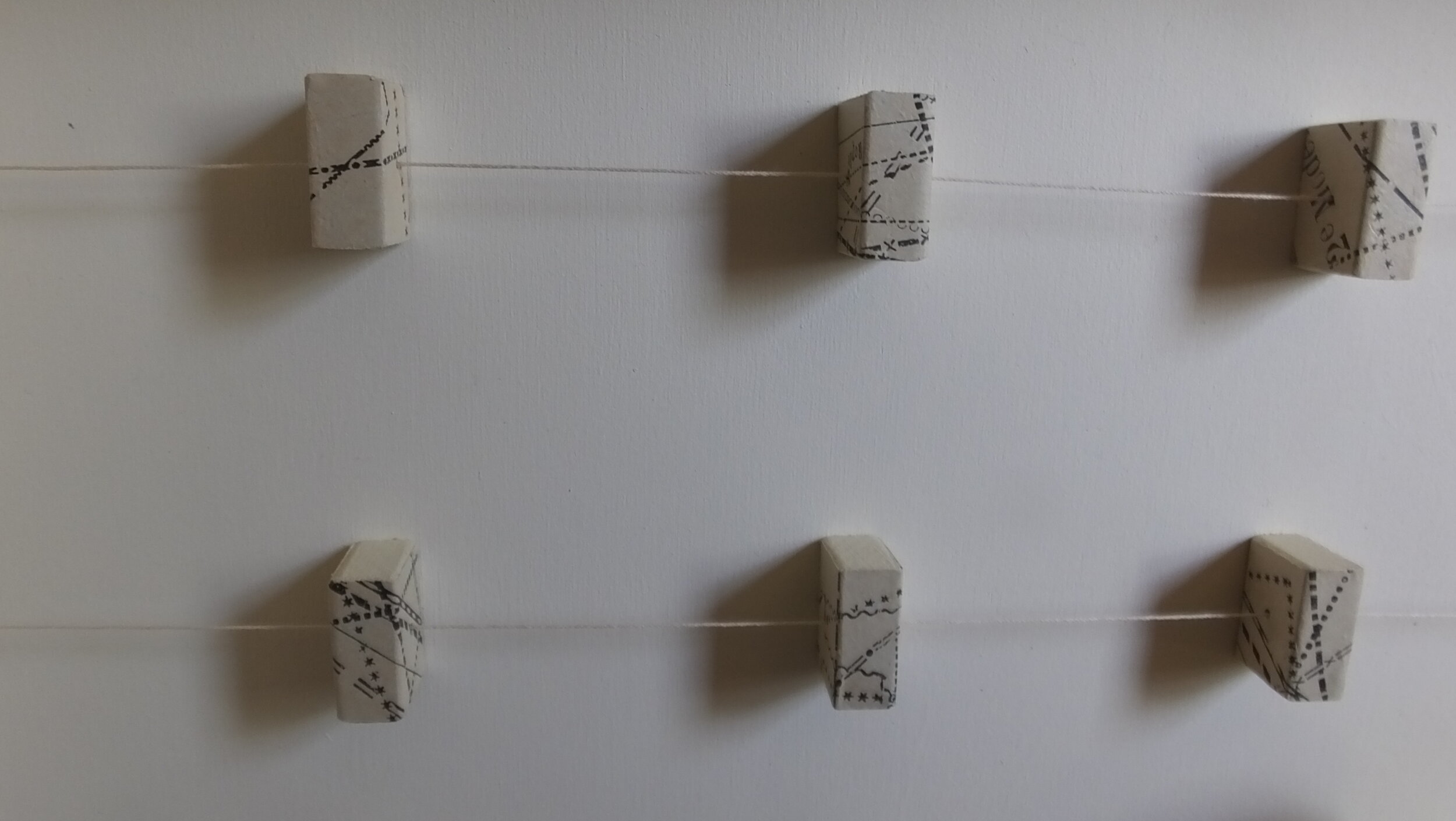Pandemic Encounter - Review by Elizabeth Stewart BA, M.Phil., M.Sc
Review 1.
Installation of Annie Abraham’s sound work, ‘Pandemic Encounter’, ATELIER MELUSINE 2020. Wallpaper ‘Wings or Lungs’ by Annett and Annett-Parish
My response to Pandemic Encounter and the spaces between
2020 Lockdown/Confinement
Atelier Melusine 1 August - 10 September 2020
For someone unaffected by Covid 19 directly, the Lockdown/Confinement gave me time and space to do as I pleased undisturbed by demands on my time. I loved it. In the first month, I occupied myself in the garden and only later returned to my atelier where I finished off three lingering pieces. Towards the end of lockdown I created just one piece which references the virus. This was inspired by reading around the subject of our changing perceptions of time during lockdown. I took as my stimulus some research into temporal anchors in which Martin Wiener explores “... whether staying at home all the time has stripped us all of our temporal anchors and set us adrift — giving us all the feeling that we don’t know when “now” is . (1)
Entitled Stripping Temporal Anchors my Covid piece is sparse; cool even. Not having been ill myself, the approach and look is intellectual and distanced. The virus is seen as something unknown and elsewhere. My interest was in how external temporal anchors such as market day, my French class, visits and meals out affected my sense of time and the notion of ‘now’.
Above; details from Stewarts piece ‘Stripping Temporal Anchors (2020) in progress
On visiting the exhibition Lockdown/Confinement, I was confronted by the raw lived experience of the virus as expressed by several artists. Unlike my cerebral approach, these artists had lived through it and their struggle with the varying symptoms was all too evident and all too present.
The notion of ‘now’ that had been for me a philosophical concept suddenly expanded into the agony of intense experience. Annett writes that the exhibition enables “the audience to enter into meditative and ritualised practices/spaces presenting different perspectives on, and of, the function of breathing and surviving the pandemic.”(2)
This is most starkly set out in Pandemic Encounter. The audience is invited to experience the soundscape of Annie Abrahams in a small upper room surrounded by “... ‘wallpaper’ of embossed flora” by Annett and Annett-Parish and where a white divan bed takes up most of the floorspace. Once the door is closed, one is confronted by the troubling sound of someone labouring to breathe and a rhythmic but distorted heartbeat.
Needless to say, this is not a comfortable space to be in. One can quickly become exhausted by the ongoing rasping and struggle for breath. The compressed plant and flower prints covering the walls are the colour of tobacco. Their pale spidery configurations are reminiscent of either scans of lungs or the delicate traces of spreading wings. Seen as wings, the eye is caught by an ancient small crucifix, crystal ball and menorah on a small window ledge described by Annett as “...a challenge to faith, identity and belief illness creates”. The only view from this tiny window is a stone wall only a foot or so away. This appears to push inwards blocking any hope of relief or escape. Tantalising snatches of sun on the wall outside, together with the birdsong on the soundscape inside, contrast with the struggling breaths of the absent, but sound-present breather. This creates an atmosphere and tension which is difficult to stay with.
Alone in this room, I was invited to experience the reality of how the virus attacks the lungs. To hear the effort involved as someone struggles to keep drawing in oxygen, moment by moment, turns virus as concept into the virus as lived experience. This is
worlds away from my analytical dalliance with the mere cerebral notions of time and ‘now’. Here, in this gallery space, the normally unconscious process of breathing is suddenly front, centre and urgent in its rasping ‘nowness’. The painful struggle of inhalation and exhalation together with the surrounding rust-coloured pressings on the walls - some with darker splodges reminiscent of dried blood - begin to overwhelm and the need to leave becomes more insistent.
I found that the only way to stay with it was to become present and ‘participate’, as best I could, by trying to breathe with the breather; to try to locate a fragile point of stillness somewhere between breaths; a small window of ‘now’ space located between the rasping, temporal, physical, anchors of inhalation and exhalation. I looked for that moment of unlimited ‘present’ space in meditation available to us when we let go of struggle. Yet letting go of struggle for this breather would mean letting go of life. So I tried to hang between in-breath and out-breath, inside and outside, lungs and wings, horror and beauty, confinement and release, life and death.
Returning home, I was left stunned and exhausted. How did a Covid sufferer, fighting for breath moment by moment, day after day, find any relief at all? How was ‘now’ experienced by them? What served as their particular temporal anchors? Was accessing any meditative ‘still’ space even possible? Then I mused on Covid in a broader context, I wondered if it proffers the perfect entry into an existential exploration of self and society in that it attacks both personal and global at the same time? If this is true, then perhaps in shattering the major collective illusion in the permanence of things, Covid has already displaced us and we sit in a collective no man’s land “...where time remains suspended in unlimited spaces - Where the law of gravity does not exist - Because there is no gravity in things” (3) We are like Annett’s Fish out of Water and stand in need of “...transformation [and] accelerated evolution” for a “new normal”. (Exhibition notes). Possibly.
Elizabeth Stewart. France. Aôut. 2020
References;
1.WEINER, Martin, PhD., Assistant Professor of Cognitive and Behavioural Neuroscience, Georgetown University, Fairfax, VA in “What day is it?” Nicola Leach, Alliance Network Partners, May 11, 2020
2.‘Pandemic Encounter’ ABRAHAMS, Annie with extracts from ‘Silences’ by Frans-van-Lent
3. ‘H.J. and the Mermaid of the Estuary - A Golem’s Warning’ Perrotta, Nadie and Fentiman-Hall, Barry
Pandemic Enounter by Annie Abrahams; Photo by Jan de Weille as part of "Pandemic Encounter’, a Networked Performance Installation by Paul Sermon in collaboration with Randall Packer, Gregory Kuhn, the Third Space Network and Leonardo Laser talks. 2020.
Pandemic Encounter - Revue par Elizabeth Stewart BA, M.Phil., M.Sc.
Ma réponse à la rencontre d'une pandémie et les espaces entre 2020 Verrouillage/Confinement Atelier Melusine 1 août - 10 septembre 2020
Pour quelqu'un qui n'est pas directement touché par le Covid 19, le Verrouillage/Confinement m'a donné le temps et l'espace pour faire ce que je voulais sans être dérangé par les exigences de mon temps. J'ai adoré. Le premier mois, je me suis occupée du jardin et ce n'est que plus tard que je suis retournée à mon atelier où j'ai terminé trois pièces qui restaient à faire. Vers la fin du confinement, j'ai créé une seule pièce qui fait référence au virus.
Cette pièce a été inspirée par la lecture du sujet de notre perception changeante du temps pendant le confinement. Je me suis inspiré d'une recherche sur les ancrages temporels dans laquelle Martin Wiener explore "... si le fait de rester chez soi tout le temps nous a dépouillés de nos ancrages temporels et nous mettre à la dérive - nous donnant tous le sentiment que nous ne savons pas quand est le "maintenant". (1) Intitulée Stripping Temporal Anchors, ma pièce Covid est rare ; elle est même cool. N'ayant pas été moi-même malade, l'approche et le regard sont intellectuels et distants. Le virus est perçu comme quelque chose d'inconnu et d'ailleurs. Je me suis intéressé à la façon dont les ancrages temporels externes, comme le jour du marché, mon cours de français, les visites et les repas au restaurant, affectaient mon sens du temps et la notion de "maintenant".
Detail from ‘Stripping Temporal Anchors’, work in progress in relation to the 2020 COVID-19 Pandemic
Détail de "Stripping Temporal Anchors", travail en cours en relation avec la pandémie COVID-19 de 2020
En visitant l'exposition Lock-down/Confinement, j'ai été confronté à l'expérience brute du virus telle qu'elle est exprimée par plusieurs artistes. Contrairement à mon approche cérébrale, ces artistes l'avaient vécu et leur lutte contre les différents symptômes n'était que trop évidente et trop présente. La notion de "maintenant", qui était pour moi un concept philosophique, s'est soudainement étendue à l'agonie d'une expérience intense. Annett écrit que l'exposition permet "au public d'entrer dans des pratiques/espaces méditatifs et ritualisés qui présentent différentes perspectives sur la fonction de la respiration et de la survie à la pandémie", ce qui est particulièrement évident dans "Pandemic Encounter". Le public est invité à découvrir le paysage sonore d'Annie Abrahams dans une petite pièce supérieure entourée de "... 'papier peint' de la flore en relief" par Annett et Annett-Parish et où un divan-lit blanc occupe la majeure partie de l'espace. Une fois la porte fermée, on est confronté au bruit troublant d'une personne qui s'efforce de respirer et à un rythme cardiaque rythmé mais déformé... Inutile de dire que ce n'est pas un espace confortable. Il va sans dire que ce n'est pas un espace confortable.
On peut rapidement s'épuiser à force de râper et de se débattre pour respirer. Les empreintes de plantes et de fleurs compressées qui recouvrent les murs sont de la couleur du tabac. Leur pâle configuration en forme d'araignée rappelle soit des balayages de poumons, soit les délicates traces d'ailes déployées. Vu comme des ailes, le regard est attiré par un ancien petit crucifix, une boule de cristal et une ménorah sur le rebord d'une petite fenêtre, décrits par Annett comme "...un défi à la foi, à l'identité et à la croyance que crée la maladie".
De cette minuscule fenêtre, on ne voit qu'un mur de pierre à environ 30 cm de distance. Ce mur semble pousser vers l'intérieur, bloquant tout espoir de soulagement ou de fuite. Des bribes de soleil tentant le mur extérieur, ainsi que le chant des oiseaux sur le paysage sonore à l'intérieur, contrastent avec les respirations difficiles de la personne absente, mais présente. Cela crée une atmosphère et une tension qu'il est difficile de maintenir.
Seul dans cette pièce, j'ai été invité à faire l'expérience de la réalité de l'attaque du virus sur les poumons. Entendre l'effort fourni par quelqu'un qui lutte pour continuer à aspirer de l'oxygène, moment par moment, transforme le virus en concept en virus en expérience vécue. C'est à mille lieues de mon flirt analytique avec les simples notions cérébrales du temps et du "maintenant". Ici, dans cette galerie, le processus normalement inconscient de la respiration est soudain au premier plan, au centre et urgent dans sa "nullité" râpeuse. La lutte douloureuse de l'inspiration et de l'expiration, ainsi que les pressions rouillées qui entourent les murs - dont certains présentent des éclaboussures plus sombres rappelant le sang séché - commencent à s'imposer et le besoin de partir devient plus insistant.
J'ai découvert que la seule façon de rester avec elle était de devenir présent et de "participer", du mieux que je pouvais, en essayant de respirer avec le respirateur ; d'essayer de localiser un point fragile de calme quelque part entre les respirations ; une petite fenêtre d'espace "maintenant" située entre les ancres râpeuses, temporelles, physiques, d'inhalation et d'expiration. J'ai cherché ce moment d'espace "présent" illimité dans la méditation qui nous est offert lorsque nous lâchons la lutte. Pourtant, lâcher la lutte pour ce souffle signifierait lâcher la vie. J'ai donc essayé de me suspendre entre l'inspiration et l'expiration, entre l'intérieur et l'extérieur, entre les poumons et les ailes, entre l'horreur et la beauté, entre l'enfermement et la libération, entre la vie et la mort. Comment une personne souffrant de Covidose, qui se bat pour respirer moment par moment, jour après jour, pouvait-elle trouver un quelconque soulagement ? Comment ont-ils vécu le "maintenant" ? Quels étaient leurs points d'ancrage temporels particuliers ?
L'accès à un espace "immobile" de méditation était-il possible ? Puis j'ai réfléchi à Covid dans un contexte plus large, je me suis demandé s'il offre une entrée parfaite dans une exploration existentielle du soi et de la société en ce sens qu'il s'attaque à la fois au personnel et au monde en même temps ? Si c'est le cas, alors peut-être qu'en brisant l'illusion collective majeure de la permanence des choses, Covid nous a déjà déplacés et nous sommes assis dans un no man's land collectif "...où le temps reste suspendu dans des espaces illimités - Où la loi de la gravité n'existe pas - Parce qu'il n'y a pas de gravité dans les choses" (A Golem's Warning. Perrotta et Fentiman-Hall). Nous sommes comme le poisson hors de l'eau d'Annett et nous avons besoin de "...transformation [et] d'évolution accélérée" pour une "nouvelle normalité" (Perrotta). Peut-être.
Elizabeth Stewart. France. Aôut 2020.
References;
1.WEINER, Martin, PhD., Assistant Professor of Cognitive and Behavioural Neuroscience, Georgetown University, Fairfax, VA in “What day is it?” Nicola Leach, Alliance Network Partners, May 11, 2020
2.‘Pandemic Encounter’ ABRAHAMS, Annie with extracts from ‘Silences’ by Frans-van-Lent
3. ‘H.J. and the Mermaid of the Estuary - A Golem’s Warning’ Perrotta, Nadie and Fentiman-Hall, Barry
Installation of Annie Abraham’s sound work, ‘Pandemic Encounter’, ATELIER MELUSINE 2020. As seen through the glass door of the gallery. Visitors have been encouraged to stay, alone in the space for a time period of five minutes - not many have been able to do so - it is a deeply moving experience which the body wishes to escape from and the frisson between beauty and death is very clear.
Installation de l'œuvre sonore d'Annie Abraham, "Pandemic Encounter", ATELIER MELUSINE 2020. Vue à travers la porte vitrée de la galerie. Les visiteurs ont été encouragés à rester seuls dans l'espace pendant une période de cinq minutes - peu ont pu le faire - c'est une expérience profondément émouvante à laquelle le corps souhaite s'échapper et le frisson entre la beauté et la mort est très clair.
Traduit avec www.DeepL.com/Translator (version gratuite)







